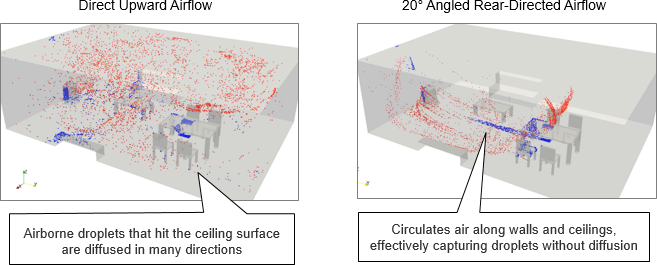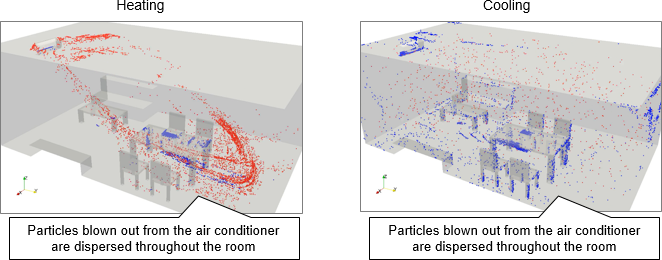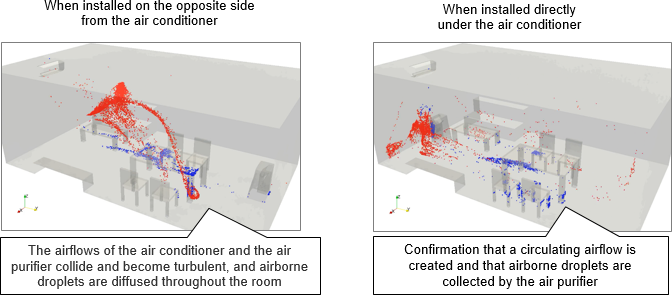
Conceptual rendering of Plasmacluster ion and airflow
Sharp Corporation and Associate Professor Masashi Yamakawa of the Kyoto Institute of Technology, an expert in the analysis of airborne virus droplets, conducted a simulation of the effect of air conditioner airflow on airborne virus droplets in a living space. We confirmed that, in contrast to conventional air purifiers, an air purifier that efficiently delivers Plasmacluster ions into the space can effectively collect airborne virus droplets*2.
Demand for air purifiers is growing. Against this backdrop, we also verified the impact of the installation location on airborne virus droplets when using Sharp’s proprietary airflow*3 air conditioner and an air purifier with our proprietary 20° Angled Rear-Directed Airflow. We also confirmed that it is effective to aim the direction of the air vented from the air conditioner upward and to place the air purifier underneath the air conditioner*4.
For nearly 20 years, since 2000, Sharp has been working toward achieving comfortable indoor air environments by using Plasmacluster and airflow technologies that efficiently deliver Plasmacluster ions as well as heating and cooling air to living spaces. In addition to air purification based on Plasmacluster technology, Sharp will continue to contribute to society by moving forward with efforts to verify the effectiveness of air-related applications based on our air purifiers/air conditioners and AIoT*5 working in tandem. These applications are also centered on Sharp’s proprietary airflow technologies for which we have conducted this current verification.
Comment from Mr. Masashi Yamakawa, Associate Professor, Kyoto Institute of Technology, and member of the Fugaku Project
Airborne virus droplets float in the air and can be inhaled by humans. For this reason, it is important to capture airborne viruses or remove them to the outdoors. Especially in the summer and winter when air conditioners are in use, ventilation is less frequent, so new measures are required. By simulating the behavior of airborne virus droplets in a room, we believe that we have found a method to reduce airborne viruses to some extent, even for environments where opening windows for ventilation is problematic.
*1 In addition to droplets generated by coughing, sneezing, talking, etc., also includes aerosols (extremely fine droplets suspended in the air).
*2 Please refer to the following for details.
*3 Coanda airflow based on Sharp’s proprietary long diffuser panel.
*4 Please refer to the following for details.
*5 AIoT is a word coined by Sharp, combining the words AI (artificial intelligence) and IoT (Internet of things).
• This current verification is only a simulation-based verification. It differs from an actual usage environment.
• "Plasmacluster" and "Device of a cluster of grapes" are trademarks of Sharp Corporation.
■ The Purpose and Role of Joint Research
With growing interest in how air conditioner airflow affects virus droplets in rooms that are not well ventilated, Sharp is looking to confirm the effectiveness of air purifiers. In collaboration with Associate Professor Yamakawa of Kyoto Institute of Technology, who specializes in particle analysis, Sharp examined the effects of airflow from air conditioners and air purifiers on virus droplets in living spaces.
Sharp calculated the speed and direction of the airflow of air conditioners and air purifiers and analyzed the movement of the airflow in a living space under simulated usage. Associate Professor Yamakawa analyzed the movement (collection to equipment, adhesion to the surroundings) when virus droplets were released based on the data analyzed by Sharp.

* For airborne virus droplets, suspended particles are shown in red and adhering particles are shown in blue.
■ Devices Used in the Simulations and Their Characteristics
In this simulation, we compared a general air purifier that sends air directly above the product with an air purifier with our proprietary 20° Angled Rear-Directed Airflow. We also did an analysis and comparison using an air conditioner equipped with a general filter with high air pass-through efficiency.

■ Simulation Conditions and Results
Simulation Conditions
Conditions assume that airborne virus droplets are diffused from the position and height of a person sitting at a dining table in a typical living/dining room (area = approx. 21.5 m2). For airborne virus droplets, suspended particles are shown in red and adhering particles are shown in blue.
Simulation 1
Overview: Comparison between air purifiers featuring Direct Upward Airflow versus 20° Angled Rear-Directed (Coanda) Airflow
Result: Confirmation that, for the direct upward airflow, the virus droplets that hit the ceiling surface are diffused in many directions. In contrast, for the 20° Angled Rear-Directed (Coanda) Airflow, the air circulates, traveling along the walls and ceiling, and virus particles are effectively captured without being dispersed in the space.

Simulation 2
Overview: Air conditioner equipped with an ordinary filter having high air pass-through efficiency during heating and cooling operation
Result: In these air conditioners, the airborne virus droplets carried on air currents and drawn into the air conditioner are not captured, but are diffused again into the room on the air flowing out from the air conditioner.

Simulation 3
Overview: Verification of optimum installation locations when Sharp’s proprietary airflow air conditioner and 20° Angled Rear-Directed Airflow air purifier are operating in tandem
Result: Confirmation that, when air from the air conditioner is blown upward and the air purifier is placed directly underneath, an airflow is created that quickly circulates around the room, enabling airborne virus droplets to be captured effectively.



 Choose
Choose